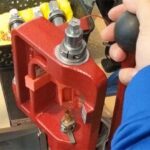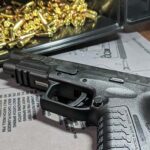So you’re making the leap and you have decided it’s time to get into reloading. Learning how to reload handgun ammunition is a great place to start for beginners. First, the process for reloading handgun ammunition is a bit easier than reloading rifle rounds. Additionally, reloading supplies are a bit cheaper for handgun ammo. Finally, many of the tools used to reload handgun ammo can be repurposed when you decide to move onto reloading rifle rounds.
I’m going to explain the process for how to reload handgun ammo from start to finish. Therefore, the sections of this article are organized chronologically. Below is a summary of the process:
- Purchase reloading tools
- Acquire raw materials for reloading
- Clean and inspect your brass casings
- Prime the casings
- Resize and flare the cases
- Measure your powder drops
- Press and crimp the bullets
- Spot check your reloads & re-calibrate your tools as necessary
- Finish your reloads and enjoy!
Table of Contents
Purchase Your Reloading Tools
Before you learn how to reload handgun ammunition, make sure you have the necessary tools. Like many other hobbies, the investment you make in your tools will be your biggest up front cost. If you plan to collect, store, and clean your own brass casings you will need more tools than someone who begins with factory or pre-washed brass.
At a bare minimum, you’ll need the following tools to be able to press your own handgun rounds:
- Reloading Press – Single Stage vs. Turret vs. Progressive Presses will differ
- Caliber specific die set
- Powder measuring scale
- Calipers
I highly recommend reading the article I’ve written about whether it’s worth it to reload your own ammo for a better understanding of the tools you need. Below is a list of the tools I use for reloading in case you want to mirror my setup.
My Handgun Ammo Reloading Tools Setup

- Hornady Lock-N-Load AP (auto progressive) Press – progressive style press, that comes with powder dispenser
- Hornady Die Set (9mm Luger – #8) – made to work with Lock-N-Load bushing system
- Hornady Shell Plate (#8) – holds the casings in place during the auto-progressive cycle
- Vinca Digital Calipers – measure case overall length (OAL) and other fine measurements
OTHER TOOLS I USE:
- Frankford Arsenal Hand De-primer – Easy way to remove old primers from spent brass
- Frankford Arsenal Hand Primer – Efficient way to insert new primers
- Frankford Arsenal Rotary Tumbler – For cleaning brass cases, wet tumbler with washing media included
- Hornady Digital Cases & Parts Dryer – Quickly dries your washed cases
- SE Magnetic Pickup Tool – Easily pickup and separate media from washed brass
Acquire Reloading Materials

In addition to purchasing the tools necessary for reloading handgun ammunition, you also need supplies. Before you go purchasing your materials, I highly suggest you pick up a reloading handbook, like the Hornady Reloading Manual (on Amazon).
A reloading manual offers in-depth information on how to reload handgun ammo to spec. For instance, you’ll learn the exact measurements for the overall length and amount of powder to use.
Depending on what type of bullet you plan to use (e.g. JHP, FMJ, etc.) your case length measurements will be different. Similarly, the brand of powder and desired bullet velocity determine the grain count for your handgun reloads.
Once you’ve done your research, it’s time to pick up your reloading supplies. To reload handgun ammunition, you’ll need to purchase primers, smokeless powder, and bullets. Additionally, if you don’t have a cache of spent casings you’ll need to purchase those also. You can pick up factory brass if you don’t want to bother with washing used cases. Alternatively there are online stores that sell used brass.
Cleaning & Inspecting Brass For Reloads
Cleaning, and more importantly inspecting, your cases are vitally important when reloading. Failing to carefully inspect your cases can result in damaged equipment and/or firearms.
Cleaning Your Casings For Reloading
There are essentially two different methods for cleaning your casings for reloads; dry and wet. Vibratory tumblers use a dry media, often walnut or corn cob. However, wet media relies on a combination of steel pins, water, and soap.
Essentially there are two reasons to clean your brass. First, spotting imperfections in your cases is much easier with clean brass especially when first learning how to reload handgun ammunition. Second, clean brass casings aren’t contaminated with any of the nasty by-products that result from shooting.
I won’t go into too much detail on the process for cleaning brass here. However, I’ve written an article and shot a video (below) on using the Frankford Arsenal Rotary Tumbler. I also cover some of the prep work like decapping the brass beforehand.
Inspecting For Imperfections
One important step in the process for how to reload handgun ammunition is ensuring your cases are adequate to be reloaded. After cleaning and drying the brass, I inspect every case for imperfections. Below are some things to be on the lookout for when inspecting handgun caliber casings for reloading.
- Deformed case neck/mouth – tears and dents which could damage reloading dies
- Compromised case head – including partial separation or deep gouges from extractors
- Damaged case body – deep dents or small tears that penetrate from outer to inner wall
- “Bell” shaped case body – indicating over-pressure
- Cases not made of brass – brass is good for reloading, other materials are questionable. I use a magnet to separate out bad cases.
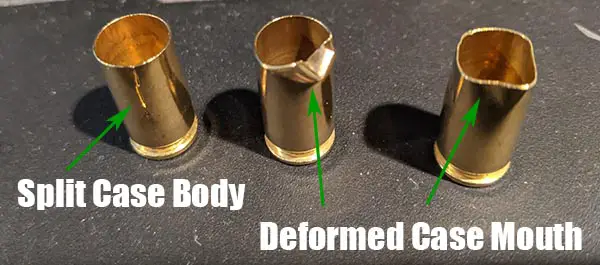
All of the above represent damaged casings that shouldn’t be reloaded because the structural integrity of the case is compromised. When you first learn how to reload handgun ammunition it’s ok to be overly conservative. As you progress you’ll understand what is and is not worth reloading.
Checking Headstamps
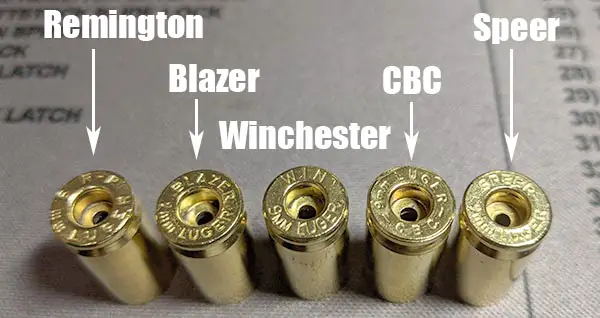
Sample of various case headstamps
Checking case headstamps is a point of contention when talking about reloads. Some people say a certain brand of ammunition is poor quality and not worth reloading. Others will say that the same manufacturer doesn’t cause any problems.
Personally, I tend to reload cases from reputable ammunition manufacturers like Remington, Federal, Fiocchi, Xtreme, and Blazer. This is not a comprehensive list but provides some basic guidance.
Unfortunately, you’ll need to decide for yourself which brands of ammunition you prefer. For this reason, it may be worth it to organize your cases to see if you experience any malfunctions as a result of a particular case brand.
Priming Your Cases
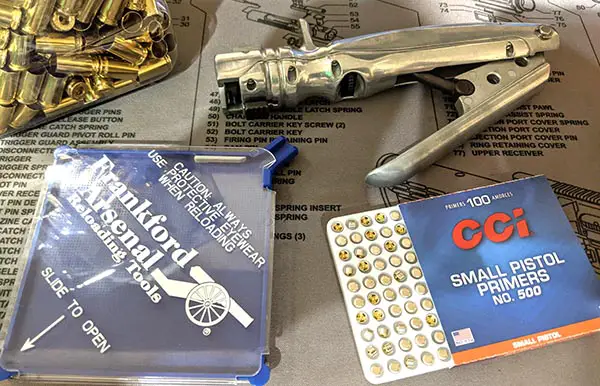
Now that you’ve got clean cases that are fit to be reloaded it’s time to begin the process. Before you prime your cases you may want/need to apply lubricant to the cases. Consult your reloading press owners manual for instruction.
I simply throw the cases in a Ziploc bag and give a few quick sprays of the lubricant into the bag, shake the cases around and move on.
Next, I prime the cases — which I do by hand. I hand prime all of my handgun reloads for 3 reasons. First, I find that using the press to prime is difficult and more trouble than it is worth. Second, I can ensure that my primers are seated to the perfect depth regardless of case and primer combination. Finally, I think the hand primer is the quickest way to prime rounds.
Resize & Flare The Cases
Once you’ve primed your cases it’s time to start resizing your brass cases. When a cartridge is fired, the heat and pressure combine to warp the case causing it to expand. Essentially, a resizing die resets the dimensions of the case to the standard dimension.
Additionally, you’ll need to flare the neck of the case to allow a new bullet to be seated into your cartridge. This is important for when you’re doing the taper crimp.
Depending on the type of press you have, your process will vary. Regardless, you’ll need to configure each die in the set for it’s intended purpose. Hornady has a video series on setting up the various dies you’ll use.
Measure Your Powder Drops
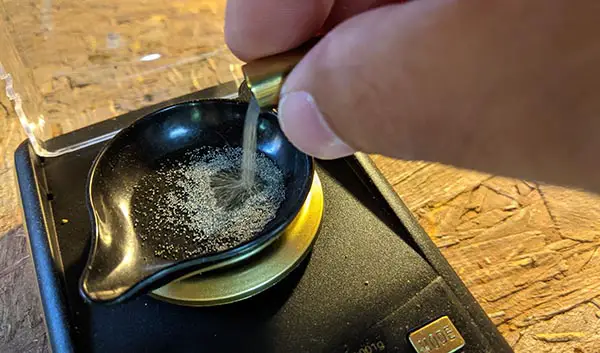
Each cartridge you reload needs smokeless powder to move the bullet down the bore and out the muzzle. Remember the reloading manual I mentioned before? If you’ve bought a brand and type of smokeless powder listed in that manual all of the information is presented in a nice little table.
Alternatively, you’ll need to consult the powder manufacturers load data. Usually this information can be found online. Here’s an example from Vhitavourri. Simply select your desired caliber and type of powder to see the load data.
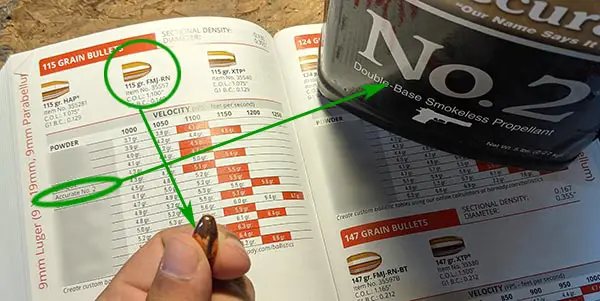
Example table for load data explained.
If you are a beginner and new to reloading, I highly recommend starting with the lowest velocity load data.
If you are new to reloading be extra careful to avoid a “double charge.” A double charge, as the name suggests, is when you drop twice the amount of powder needed into a case. Exceeding the amount of grains can result in extreme pressures that your handgun is unable to handle.
Regardless of whether you opt for a single stage press, turret press, or a progressive press, always visually inspect your powder drop. Additionally, beginners may want to consider a lockout die. These dies are designed to detect “no powder” and “double powder” charges.
Press The Bullets & Crimp Your Reloads

Now that you have your powder dropped the last step is adding the bullet and crimping the case. If you’ve properly flared your case, the bullet should rest just inside the neck of the case. A pull of the reloading press handle and the bullet will seat to the appropriate depth.
Additionally, when the bullet is seated a taper crimp is suitable for reloading handgun ammunition. A taper crimp will undo the flare of the case neck and hold the seated bullet in place. Do not over-crimp the cartridge as this can lead to excessive pressure buildup.
Check Your Reloads & Recalibrate
It’s important for beginner reloaders to check their work and always remained focused on the task at hand. I tend to check one reload every 25 rounds or so. Here’s the process I use to check my reloads.
- Check case OAL (overall length) – ensure I am within margins
- Check case neck diameter – ensure I the crimp is not overly aggressive
- Pull the bullet and measure the charge – ensure my powder drops are within margins
I recommend when you check your reloads frequently and invest in a bullet puller. This tool allows you to easily and safely disassemble a cartridge. Afterwards you can re-use the supplies to reload.
If any of your reloads are way out of spec, I recommend pulling the entire batch of reloads. Then check your tool setup before beginning to reload again. When reloading for beginners, start with small batches of ammunition and work your way up. As you get more comfortable you can increase your batch counts.
Parting Shots
I understand that this material is a bit lengthy. However, I wanted to provide as much detail as possible for those new to reloading. Hopefully this article provided you a thorough understanding of how to reload handgun ammunition.
Although the process can be time consuming it is also very rewarding. I congratulate anyone with the courage, discipline, and drive who presses their own ammunition. For these reasons I highly encourage you to give reloading a shot.
If you found this article helpful, please share with your network since it helps me out a lot. Are you an avid shooter who also reloads? If you have anything to add, please leave a comment for those who come after you. Thanks for stopping by.

